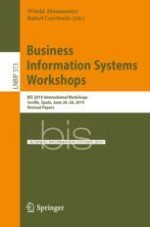This book constitutes revised papers from the nine workshops and one accompanying event which took place at the 22nd International Conference on Business Information Systems, BIS 2019, held in Seville, Spain, in June 2019. There was a total of 139 submissions to all workshops of which 57 papers were accepted for publication.
The workshops included in this volume are: AKTB 2019: 11th Workshop on Applications of Knowledge-Based Technologies in Business BITA 2019: 10th Workshop on Business and IT Alignment BSCT 2019: Second Workshop on Blockchain and Smart Contract Technologies DigEX 2019: First International Workshop on transforming the Digital Customer Experience iCRM 2019: 4th International Workshop on Intelligent Data Analysis in Integrated Social CRM iDEATE 2019: 4th Workshop on Big Data and Business Analytics Ecosystems ISMAD 2019: Workshop on Information Systems and Applications in Maritime Domain QOD 2019: Second Workshop on Quality of Open Data SciBOWater 2019: Second Workshop on Scientific Challenges and Business Opportunities in Water Management
